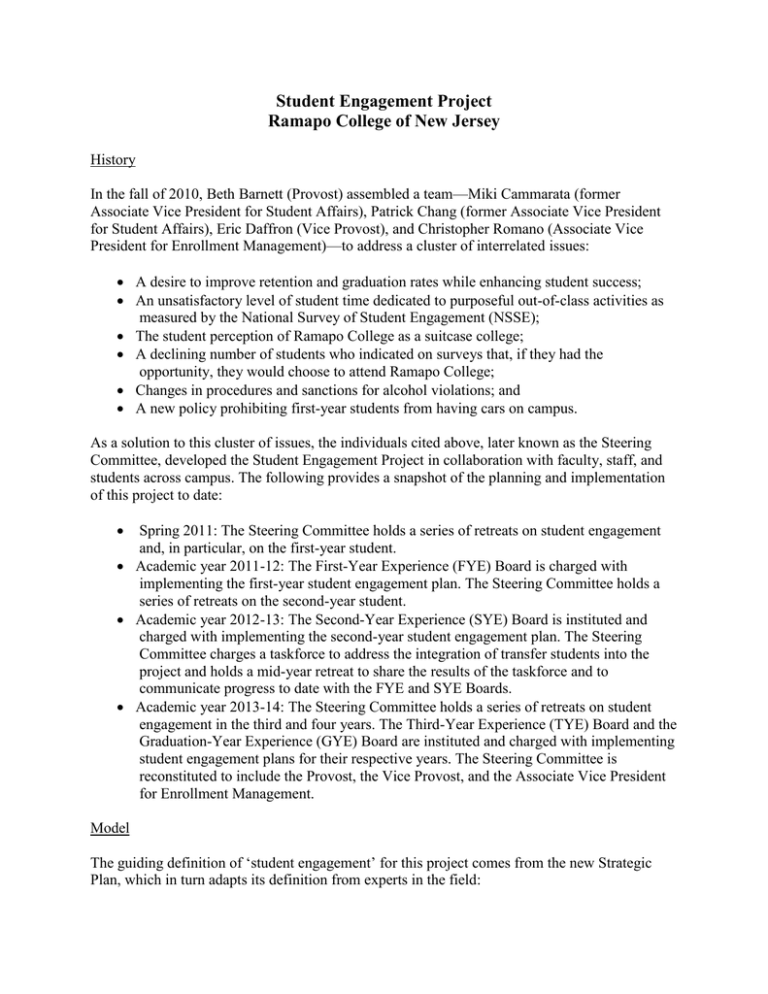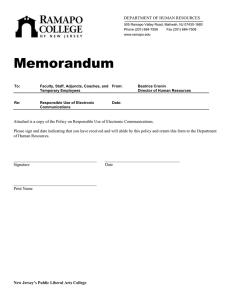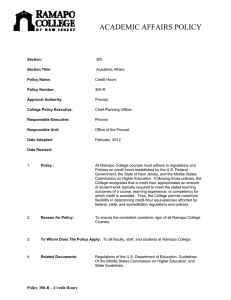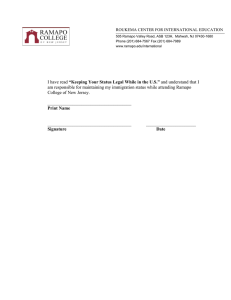Student Engagement Project Ramapo College of New Jersey
advertisement

Student Engagement Project Ramapo College of New Jersey History In the fall of 2010, Beth Barnett (Provost) assembled a team—Miki Cammarata (former Associate Vice President for Student Affairs), Patrick Chang (former Associate Vice President for Student Affairs), Eric Daffron (Vice Provost), and Christopher Romano (Associate Vice President for Enrollment Management)—to address a cluster of interrelated issues: A desire to improve retention and graduation rates while enhancing student success; An unsatisfactory level of student time dedicated to purposeful out-of-class activities as measured by the National Survey of Student Engagement (NSSE); The student perception of Ramapo College as a suitcase college; A declining number of students who indicated on surveys that, if they had the opportunity, they would choose to attend Ramapo College; Changes in procedures and sanctions for alcohol violations; and A new policy prohibiting first-year students from having cars on campus. As a solution to this cluster of issues, the individuals cited above, later known as the Steering Committee, developed the Student Engagement Project in collaboration with faculty, staff, and students across campus. The following provides a snapshot of the planning and implementation of this project to date: Spring 2011: The Steering Committee holds a series of retreats on student engagement and, in particular, on the first-year student. Academic year 2011-12: The First-Year Experience (FYE) Board is charged with implementing the first-year student engagement plan. The Steering Committee holds a series of retreats on the second-year student. Academic year 2012-13: The Second-Year Experience (SYE) Board is instituted and charged with implementing the second-year student engagement plan. The Steering Committee charges a taskforce to address the integration of transfer students into the project and holds a mid-year retreat to share the results of the taskforce and to communicate progress to date with the FYE and SYE Boards. Academic year 2013-14: The Steering Committee holds a series of retreats on student engagement in the third and four years. The Third-Year Experience (TYE) Board and the Graduation-Year Experience (GYE) Board are instituted and charged with implementing student engagement plans for their respective years. The Steering Committee is reconstituted to include the Provost, the Vice Provost, and the Associate Vice President for Enrollment Management. Model The guiding definition of ‘student engagement’ for this project comes from the new Strategic Plan, which in turn adapts its definition from experts in the field: Student engagement is the result of the time and effort students devote to activities empirically linked to the intended outcomes of college and what institutions do to both provide these activities and induce students to participate in them (Kuh, 2003). Student engagement is characterized by critical examination, analysis, reflection, and problem solving (Brownell & Swaner, 2010). This definition informs research on several so-called high-impact activities, such as first-year seminars, study abroad, capstone experiences, and living-learning communities, as well as the National Survey of Student Engagement (NSSE), which the College administers every other year. Although Ramapo’s Student Engagement Project is indebted to national experts, the College has developed a unique model. This model incorporates four overarching engagement goals— academic, social, personal, and community/civic—each of which is supported by a series of outcomes informed by national research and embraced by campus stakeholders. These outcomes articulate what all Ramapo students should know or be able to do over the course of their four years of college. To enable students to meet these outcomes, the Steering Committee and the project’s participants have identified several Key Points of Engagement (KPEs). The definition of a KPE varies slightly from one year of a student’s experience to the next but always includes the following criterion: A high-impact activity or an activity leading to a high-impact activity, meaning that it is: o A substantive interaction, in class and out of class, with peers, faculty, and staff or o A common experience that deepens understanding of self and others or o An opportunity to connect in-class and out-of-class learning. These KPEs have become priority activities for the College. Governance and Operations The Student Engagement Project has a two-fold governance structure. The Steering Committee guides and evaluates the overall project, determines next major steps, and allocates funding. Members of the Steering Committee also serve as liaisons to the four Boards, whose chairs report to the Steering Committee. Each board is charged with implementing, assessing, and enhancing a student engagement plan for a particular year in a student’s time at the College. To assess the effectiveness of the project, each board sets annual targets, collects and analyses data generated from various measures (e.g., ID swipes and surveys), and identifies ways to enhance student engagement based on assessment results. Over time, annual assessment results coupled with NSSE results as well as retention and graduation rates will allow the College to determine the effectiveness of the project. Future directions This project supports, in part, the academic excellence and engagement goal in the College’s new Strategic Plan, which includes specific objectives and targets for student engagement. In fact, student engagement figures prominently in the College’s revised mission statement. Thus, student engagement has become an institutional priority. Resources Ramapo’s Student Engagement website (http://www.ramapo.edu/provost/student/) provides a host of resources and documents, including, but not limited to, goals and outcomes, definitions of KPEs, maps aligning outcomes to KPEs, and board charges. References Brownell, J.E., Swaner, L.E. (2010) High-impact practices: Research on learning outcomes, completion, and quality. Washington, DC: Association of American Colleges and Universities. Kuh, G. D. (2003) What we’re learning about student engagement from NSSE. Change, 35(2), 24-32.


